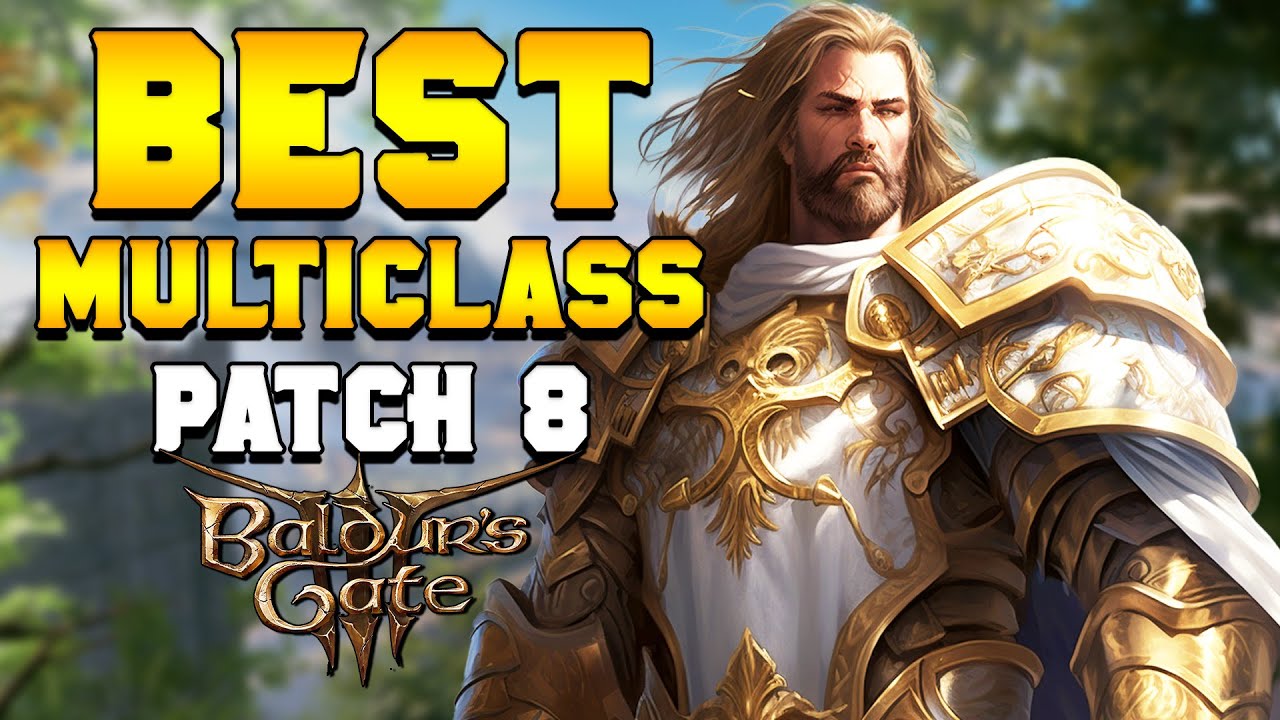Master the Art of Multiclassing Baldur’s Gate 3’s Explosive New Patch 8 Subclasses for Unstoppable Builds
The release of Patch 8 for Baldur’s Gate 3 in April 2025 unleashed a game-changing wave of 12 new subclasses, revitalizing character builds and sending theorycrafters into a frenzy. From the swashbuckling Rogue to the thunderous Barbarian, these additions have expanded the game’s already vast customization options, making multiclassing more enticing than ever. But with a level cap of 12 and the complexity of synergizing classes, how do you effectively multiclass these new subclasses to dominate Faerun? This guide dives into the mechanics of multiclassing, explores the new subclasses introduced in Patch 8, and offers strategic combinations to create powerful, versatile characters that shine in combat, roleplay, and beyond.

Understanding Multiclassing in Baldur’s Gate 3
Multiclassing in Baldur’s Gate 3 allows players to combine levels from multiple classes, blending their abilities to craft unique builds. Unlike Dungeons & Dragons 5th Edition, Baldur’s Gate 3 removes ability score prerequisites, enabling unrestricted class combinations. Multiclassing becomes available at Level 2, except on Explorer difficulty, where it’s disabled to simplify gameplay for newcomers. To multiclass, players click the “Add Class” button on the level-up screen, selecting a new class and, if applicable, a subclass at the required level (typically Level 3 for most classes).
The game’s level cap of 12 means every level invested in a secondary class reduces progression in the primary class, potentially delaying or locking out high-level features like Extra Attack (Level 5 for martial classes) or 6th-level spells. Successful multiclassing hinges on synergy, leveraging shared ability scores (e.g., Charisma for Sorcerer and Warlock) or complementary mechanics (e.g., Barbarian’s Rage with Fighter’s Action Surge). Respeccing via Withers at camp allows players to experiment without permanent consequences, making multiclassing a low-risk, high-reward endeavor.
Patch 8’s new subclasses, announced by Larian Studios, include one for each of the 12 base classes, each offering unique mechanics that enhance multiclass potential. Below, we explore these subclasses and recommend multiclass builds to maximize their strengths, based on community insights and gameplay analysis.
Patch 8’s New Subclasses: A Quick Overview
Patch 8 introduced the following subclasses, each unlocking at the standard subclass selection level for their respective class (Level 3 unless noted otherwise):
Barbarian: Path of the Zealot – A divinely inspired warrior who resists death and deals radiant or necrotic damage. Unlocks at Level 3.
Bard: College of Glamour – A fey-inspired performer with enchanting abilities and crowd-control magic. Unlocks at Level 3.
Cleric: Forge Domain – A smith deity’s champion, enhancing armor and weapons with divine craftsmanship. Unlocks at Level 1.
Druid: Circle of Stars – A celestial-focused caster with star-guided forms for healing, damage, or utility. Unlocks at Level 2.
Fighter: Arcane Archer – A marksman infusing arrows with magical effects. Unlocks at Level 3.
Monk: Way of the Drunken Master – A staggering martial artist excelling in crowd control and mobility. Unlocks at Level 3.
Paladin: Oath of the Crown – A knight sworn to protect civilization, with defensive auras and crowd-control spells. Unlocks at Level 3.
Ranger: Swarmkeeper – A nature warrior commanding swarms for battlefield control. Unlocks at Level 3.
Rogue: Swashbuckler – A flamboyant duelist thriving in one-on-one combat with enhanced mobility. Unlocks at Level 3.
Sorcerer: Shadow Magic – A sorcerer wielding darkness and summoning shadowy hounds. Unlocks at Level 1.
Warlock: Hexblade – A pact with a sentient weapon, using Charisma for melee attacks. Unlocks at Level 1.
Wizard: Bladesinging – A sword-wielding mage blending spellcasting and melee prowess. Unlocks at Level 2.
These subclasses, detailed in Larian’s Patch 8 guides, offer fresh mechanics that pair well with existing classes, making them prime candidates for multiclassing.
How to Multiclass the New Subclasses
Below are strategic multiclass builds for each new subclass, designed to enhance their strengths, mitigate weaknesses, and align with the level cap. Each build assumes a Balanced, Tactician, or Honour Mode playthrough, as multiclassing is disabled in Explorer Mode.
1. Barbarian: Path of the Zealot
Build: Zealot Barbarian 8 / Champion Fighter 4
Why It Works: The Zealot’s ability to resist death (Fanatical Focus) and deal bonus radiant/necrotic damage pairs excellently with Fighter’s Action Surge and Champion’s Critical Hit improvement (Improved Critical). Barbarian’s Rage enhances melee damage, while Fighter’s Second Wind and Fighting Style (e.g., Great Weapon Fighting) boost survivability and versatility. Take Barbarian to Level 8 for Relentless Rage, then Fighter to Level 4 for an Ability Score Increase (ASI) or Feat like Great Weapon Master.
Key Abilities: Strength (primary), Constitution (secondary).
Playstyle: A tanky damage-dealer who shrugs off death and lands devastating critical hits.
2. Bard: College of Glamour
Build: Glamour Bard 10 / Hexblade Warlock 2
Why It Works: Glamour’s enchanting abilities (Mantle of Inspiration) synergize with Warlock’s Charisma-based Eldritch Blast and Agonizing Blast. The Hexblade’s Charisma-based melee attacks complement Bard’s light armor proficiency, creating a versatile gish (melee-spellcaster hybrid). Take Bard to Level 10 for high-level spells and Magical Secrets, then dip into Warlock for short-rest spell slots. Key Abilities: Charisma (primary), Dexterity (secondary).
Playstyle: A charismatic support caster who controls crowds and dishes out ranged or melee damage.
3. Cleric: Forge Domain
Build: Forge Cleric 8 / Battle Master Fighter 4
Why It Works: Forge’s armor and weapon enhancements (Blessing of the Forge) pair with Fighter’s Action Surge and Battle Master’s Superiority Dice for tactical combat maneuvers. Cleric’s divine spells provide support, while Fighter adds martial prowess. Take Cleric to Level 8 for Divine Strike, then Fighter for a Feat like Sentinel.
Key Abilities: Wisdom (primary), Strength (secondary).
Playstyle: A durable frontline cleric with enhanced gear and precise attacks.
4. Druid: Circle of Stars
Build: Stars Druid 10 / Life Cleric 2
Why It Works: Stars’ celestial forms (Chalice, Archer, Dragon) offer versatile spellcasting, while Life Cleric’s Disciple of Life boosts healing spells. Both use Wisdom, ensuring spellcasting efficiency. Take Druid to Level 10 for Cosmic Omen, then Cleric for early healing boosts. Key Abilities: Wisdom (primary), Constitution (secondary).
Playstyle: A healer and utility caster with celestial-themed versatility.
5. Fighter: Arcane Archer
Build: Arcane Archer Fighter 8 / Gloom Stalker Ranger 4
Why It Works: Arcane Archer’s magical arrows (Grasping Arrow, Shadow Arrow) combine with Gloom Stalker’s first-turn burst damage (Dread Ambusher) and stealth. Ranger’s spells like Hunter’s Mark enhance ranged output. Take Fighter to Level 8 for Extra Attack and a Feat (Sharpshooter), then Ranger for Umbral Sight. Key Abilities: Dexterity (primary), Wisdom (secondary).
Playstyle: A deadly ranged sniper with magical and stealthy tricks.
6. Monk: Way of the Drunken Master
Build: Drunken Master Monk 8 / Swashbuckler Rogue 4
Why It Works: Drunken Master’s mobility (Drunken Technique) and crowd control pair with Swashbuckler’s one-on-one dueling (Rakish Audacity) and Sneak Attack. Both rely on Dexterity, ensuring synergy. Take Monk to Level 8 for Evasion, then Rogue for a Feat like Dual Wielder. Key Abilities: Dexterity (primary), Wisdom (secondary).
Playstyle: A nimble skirmisher excelling in hit-and-run tactics.
7. Paladin: Oath of the Crown
Build: Crown Paladin 7 / Storm Sorcery Sorcerer 5
Why It Works: Crown’s defensive auras (Champion Challenge) complement Sorcerer’s lightning-themed spells and mobility (Tempestuous Magic). Paladin’s Divine Smite pairs with Sorcerer’s Metamagic for burst damage. Take Paladin to Level 7 for Aura of Protection, then Sorcerer for Quickened Spell.
Key Abilities: Charisma (primary), Strength (secondary).
Playstyle: A tanky spell-sword with crowd control and electric flair.
8. Ranger: Swarmkeeper
Build: Swarmkeeper Ranger 7 / Assassin Rogue 5
Why It Works: Swarmkeeper’s swarm abilities (Gathered Swarm) enhance battlefield control, while Assassin’s Sneak Attack and Assassinate amplify first-turn damage. Both use Dexterity, ensuring cohesive stats. Take Ranger to Level 7 for Writhing Tide, then Rogue for Evasion. Key Abilities: Dexterity (primary), Wisdom (secondary).
Playstyle: A stealthy ranger with swarm-driven burst damage.
9. Rogue: Swashbuckler
Build: Swashbuckler Rogue 8 / Battle Master Fighter 4
Why It Works: Swashbuckler’s dueling prowess (Fancy Footwork) pairs with Battle Master’s Superiority Dice for tactical strikes. Fighter’s Action Surge boosts action economy. Take Rogue to Level 8 for Reliable Talent, then Fighter for a Feat like Sentinel. Key Abilities: Dexterity (primary), Constitution (secondary).
Playstyle: A flashy duelist with precise, high-damage attacks.
10. Sorcerer: Shadow Magic
Build: Shadow Magic Sorcerer 10 / Hexblade Warlock 2
Why It Works: Shadow Magic’s darkness manipulation (Eyes of the Dark) synergizes with Hexblade’s Charisma-based melee and Eldritch Invocations. Warlock’s short-rest slots fuel Sorcerer’s Metamagic. Take Sorcerer to Level 10 for Shadow Walk, then Warlock for Agonizing Blast. Key Abilities: Charisma (primary), Constitution (secondary).
Playstyle: A shadowy caster with melee and ranged versatility.
11. Warlock: Hexblade
Build: Hexblade Warlock 5 / Devotion Paladin 7
Why It Works: Hexblade’s Charisma-based attacks (Hex Warrior) pair with Paladin’s Divine Smite and Aura of Protection. Pact of the Blade enhances melee, while Paladin adds tankiness. Take Warlock to Level 5 for Thirsting Blade, then Paladin for Sacred Weapon. Key Abilities: Charisma (primary), Strength (secondary).
Playstyle: A charismatic warrior blending magic and melee.
12. Wizard: Bladesinging
Build: Bladesinging Wizard 8 / Eldritch Knight Fighter 4
Why It Works: Bladesinging’s melee-spellcasting hybrid (Bladesong) synergizes with Eldritch Knight’s weapon bond and Action Surge. Fighter’s armor proficiency boosts survivability. Take Wizard to Level 8 for 4th-level spells, then Fighter for a Feat like War Caster. Key Abilities: Intelligence (primary), Dexterity (secondary).
Playstyle: A nimble spell-sword with high AC and spell versatility.
Tips for Effective Multiclassing
Plan Around the Level Cap: With only 12 levels, prioritize classes that gain key features early (e.g., Warlock’s Level 1 Hexblade) to avoid missing high-level abilities.
Synergize Ability Scores: Combine classes with shared primary stats (e.g., Dexterity for Rogue/Ranger) to maximize effectiveness.
Balance Combat and Roleplay: Multiclassing unlocks unique dialogue options, enhancing immersion. For example, a Glamour Bard/Hexblade Warlock gains fey and fiendish dialogue.
Use Feats Strategically: ASIs at Levels 4, 8, and 12 are critical. Feats like Sharpshooter (for Arcane Archer) or Sentinel (for Crown Paladin) amplify builds.
Respec Freely: Withers allows respeccing for minimal gold, so experiment with builds to find what suits your playstyle.
Why These Builds Are Trending
Patch 8’s subclasses have reinvigorated Baldur’s Gate 3, with the Hexblade Warlock and Swashbuckler Rogue earning praise as top-tier multiclass options. Community discussions on X highlight the Hexblade’s “OP 1-level dip” for Charisma-based builds and the Swashbuckler’s newfound strength as a pure Rogue or multiclass duelist. These builds shine in Honour Mode, where versatility and synergy are crucial, and their thematic flair—swashbuckling rogues, star-guided druids, blade-dancing wizards—adds roleplay depth. As players test these combos, the Baldur’s Gate 3 community continues to uncover diabolical strategies, proving that multiclassing remains the heart of creative character-building—Discover Why These Combos Are Dominating Faerun!





